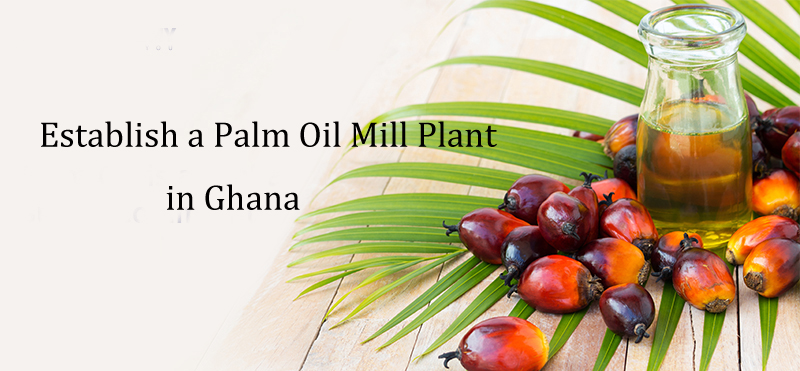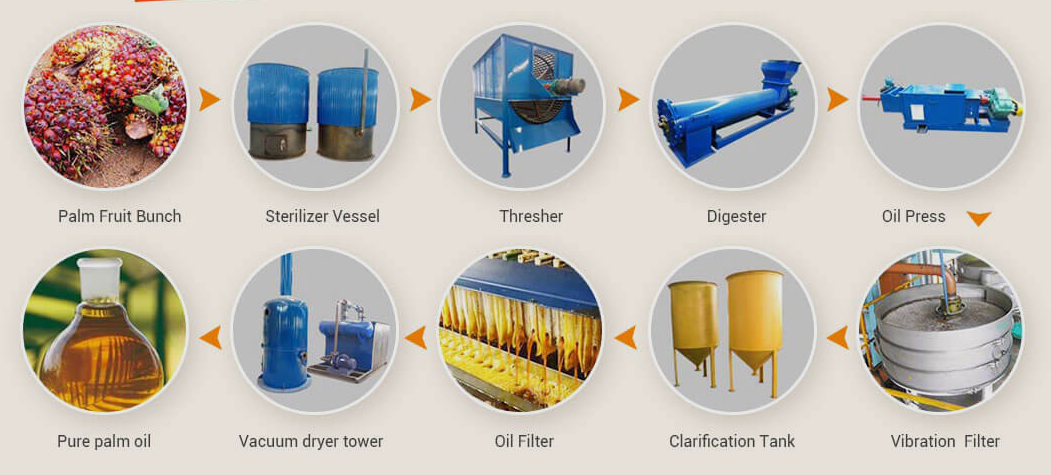
In Ghana, the oil palm has assumed increasing importance as a non-traditional export commodity. An estimated total land area of 305, 758 hectares is under oil palm cultivation in Ghana. It is estimated that 243,852tons of palm oil is being produced. But Ghana currently has an unmet demand of 35,000tons of palm oil. The estimated unmet demand in the ECOWAS sub-region is 850,000tons. In order to meet the large unmet demand in Ghana and the large markets in the West African region. The demand for palm oil machine is very large .So the prospects for the palm oil production in Ghana is profitable.

Palm oil production is a structured, time-sensitive process that requires specialized equipment and strict quality control to preserve oil integrity.(Latest post: 1-5TPH Complete Set Palm Oil Processing Line)

A typical palm oil production line in Ghana follows eight core stages, each critical to maximizing yield and minimizing waste:
1. Fresh Fruit Bunch (FFB) Reception
Oil palms bear fruit year-round, and FFBs must be processed within 48 hours of harvesting to avoid rising acid levels that degrade oil quality. Upon arrival at the mill, FFBs are weighed, inspected for ripeness, and unloaded onto a loading ramp—equipped with conveyors to transport bunches to the next stage.
2. Sterilization
Within 24 hours of reception, FFBs are fed into high-temperature sterilization tanks. This process softens the fruit, kills bacteria, prevents free fatty acid buildup, and loosens the connection between fruits and bunches—all essential for efficient downstream processing. Steam is the most common heat source, often generated on-site via boilers.
3. Threshing
Sterilized FFBs move to threshing machines, which separate palm fruits from empty fruit bunches (EFBs). EFBs are not discarded; they serve as a renewable fuel source for the mill’s boilers or as organic fertilizer for plantations, reducing waste and operational costs. The separated fruits are then elevated to the digesting stage.
4. Digesting & Pressing
Fruits are cooked again in a digester to further soften the pulp and separate it from the palm kernels. The mashed pulp is then fed into screw presses, which apply mechanical pressure to extract crude palm oil (CPO) and a fibrous byproduct called press cake. Press cake is often used as animal feed, adding another revenue stream.
5. Oil Clarification
Extracted CPO contains impurities like water, pulp fragments, and sediment. It is pumped into clarification tanks, where gravity separates the oil from solids and water. For higher-purity oil, some mills add centrifuges to accelerate separation—critical for meeting export or refined oil standards.
6. Kernel Recovery
Palm kernels (which contain valuable palm kernel oil) are separated from the press cake using polishing drums and grading screens. The kernels are dried in bunkers to reduce moisture content, then stored for onward processing or sale to kernel oil mills.
7. Effluent Treatment
Wastewater from the process (known as palm oil mill effluent, POME) requires treatment to comply with Ghana Environmental Protection Agency (EPA) regulations. Modern mills use anaerobic digesters or lagoon systems to break down organic matter, ensuring discharged water meets environmental standards.
8. Storage & Distribution
Clarified CPO is stored in temperature-controlled tanks to prevent oxidation. For domestic sale, it may be packaged directly; for export or refining, it is loaded into tanker trucks or shipping containers. Refined palm oil undergoes additional processes (degumming, neutralization, bleaching, deodorization) to produce cooking oil, shortening, or industrial-grade oil.
The cost of establishing a palm oil mill plant in Ghana varies widely based on scale (small, medium, large), automation level, location, and whether it includes a refinery. (You may also like Palm Oil Mill Plant Setup Costs in Nigeria >>)
Below is a breakdown of key expenses, focused on medium-sized mills (the most common for investors entering the market):
1. Land Acquisition
Medium-sized mills require 50–100 acres of land for buildings, equipment, storage, and future expansion. Costs depend on location: rural areas near plantations (e.g., Western Region) cost $5,000–$15,000 per acre, while urban or peri-urban land (e.g., near Accra) can exceed $20,000 per acre. Total land costs typically range from $500,000 to $1.5 million. Engaging local lawyers to verify land titles (critical in Ghana’s mixed ownership system of state, family, and chief-owned land) adds $10,000–$30,000 in legal fees.
2. Construction & Infrastructure
This includes building factories, storage tanks, boiler rooms, effluent treatment plants, and access roads. For a medium-sized mill, construction costs average $3–$5 million, covering materials, labor, and site preparation. Additional infrastructure like electricity backup (generators) and water supply systems adds $200,000–$500,000, given Ghana’s occasional power outages.
3. Equipment Costs
Specialized processing equipment represents a major expense. A medium-sized mill requires sterilizers, threshers, digesters, presses, clarifiers, kernel recovery systems, and boilers. Equipment costs range from $2–$5 million, with higher prices for automated or imported machinery (e.g., European centrifuges vs. Chinese presses). Transportation and installation of equipment add $100,000–$300,000, plus engineer fees for debugging ($50,000–$100,000 over a 2-month installation period).
4. Compliance & Certification
Ghana mandates environmental permits (via EPA) and production licenses (from the Ministry of Food and Agriculture). Costs for environmental impact assessments (EIAs) and permits total $50,000–$150,000. For export-focused mills, certifications like Global Sustainable Palm Oil (RSPO) add $100,000–$200,000 but unlock premium markets.
5. Labor & Training
Ghana’s labor laws cap foreign employees at 10% of staff, so mills rely primarily on local workers. A medium-sized mill needs 50–100 employees (managers, technicians, operators, administrative staff). Annual labor costs average $500,000–$1 million, including salaries, social security contributions, and initial training (e.g., equipment operation, safety protocols).
6. Working Capital & Operational Costs
Initial working capital covers FFB sourcing, utilities, maintenance, and logistics for the first 6–12 months. This ranges from $500,000 to $2 million, depending on supply chain length and production volume. Ongoing operational costs include electricity ($10,000–$20,000/month), FFB purchases (if no plantation), and maintenance ($50,000–$100,000/year).